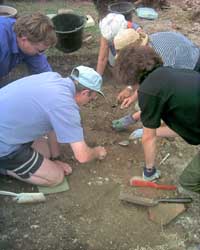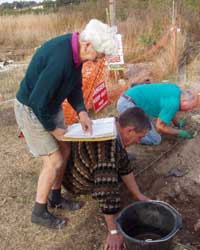The SOAG Roman Villa Excavation and Landscape Project.
This is the group's main field research project at present, the excavation of a Roman villa site near Goring-on-Thames, which is well advanced with a large area of the villa now exposed. The project also includes an extensive survey of the landscape around the villa.
(Update for 2019: The 2019 digging season will be our last at this site, and accordingly we have some very specific and limited objectives. Accordingly we will only be able to accommodate SOAG members at the site. Unlike previous seasons we cannot provide digging opprtnitiess for non-members, nor accpet visits from groups of visitors. (SOAG members should consult the SOAG Calendar for digging dates this year).
|
Latest: SOAG has been
pioneeriing the use of 3D photography for its trenches and finds.
The best of these are demontrated in this
webpage. Perhaps our most
exciting recent finds are two almost complete
examples of a 3rdC AD drinking beakers made in Trier. See and
manipulate the 3D models
here. |
|
Plan of the villa at end of 2018

The volunteers
The project is run by experienced archaeologists and volunteers, participating in field walking, geophysical surveys, excavation and post-excavation work. Due to the support and enthusiasm of the landowner, SOAG has been able to excavate at the site every summer since 1993. We have good contacts with the Oxfordshire County Archaeologist and with Oxford Archaeology. This enables us to offer basic training and useful experience to people of all ages and ability while continuing to maintain good standards of excavation and recording.

Hypocaust and stokeroom, trench 7
Discovery of the site and early excavation
SOAG volunteers assisted on the excavation of a nearby pipeline route in the 1980s. This produced evidence of occupation from early post-glacial to the Bronze Age and again in the Roman and Saxon periods. A Roman corndrier was discovered and the trackways and enclosures of a Roman farmstead, probably set out in the 2nd century. SOAG began a programme of fieldwalking to locate the villa building. After some trial trenches, phase 1 of the excavation began at the eastern end of the site, over a linear feature in the field where the landowner said his plough often caught on large flints. A boundary ditch and the flint wall of the villa building was discovered. The ditch was filled with Roman material; roof tiles, building rubble, painted wall plaster, pottery, bone and other artefacts, including a small bronze trinket ring with a pale green glass bezel. This part of the villa building was a working area with many small furnaces and hearths, one with evidence of metalworking. The most interesting find was a large iron ladle, with a distinctive 'twisted' handle, found beneath the largest flint stone on the site. It must have been deliberately placed there, perhaps when the villa was abandoned. Phase 2 of the excavation began in 2000, with the opening up of trenches over the western end of the villa.

Cyn (SOAG President) in the hypocaust, 2002
The villa building
This 3rd-4th century villa, which may be an example of a aisled building, stood within a large rectangular enclosure, facing south, towards the River Thames. Three or more large central rooms are linked on the south or front elevation by a corridor or range of small rooms. There may be a similar corridor on the north side. A working area at the eastern end of the building has small hearths and furnaces. At the western end a small bath house or suite of heated rooms is attached to the building. Many of the flint and chalk wall footings and floors survive in good preservation, relatively undisturbed by later farming and robbing out of the walls.

Uncovering a tesselated floor

Recording a small find
There is more information about the villa site available in the SOAG members area of this website.
Note that all SOAG projects are covered by policies for Insurance, Child protection, and Health and Safety
Project Director
Hazel Williams.

